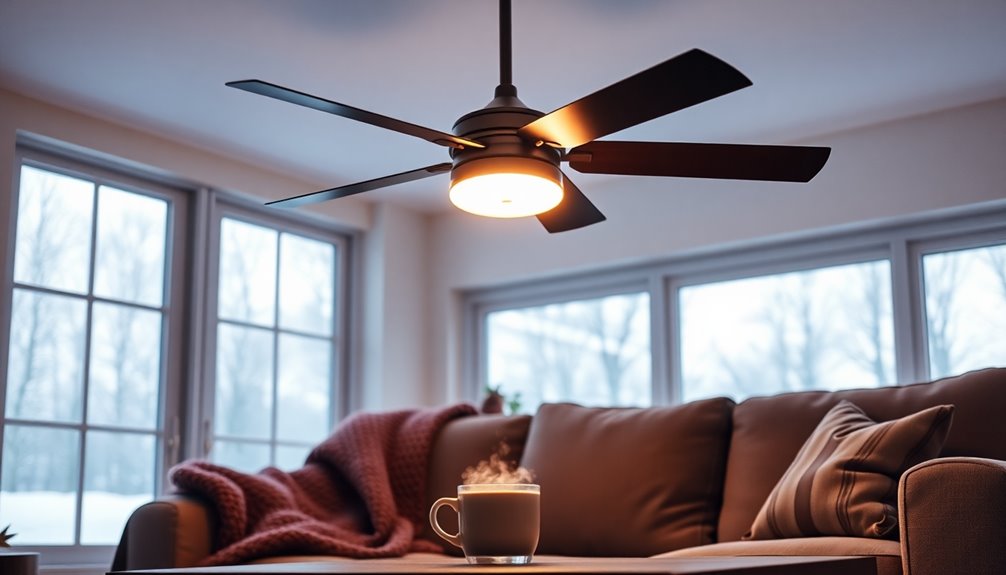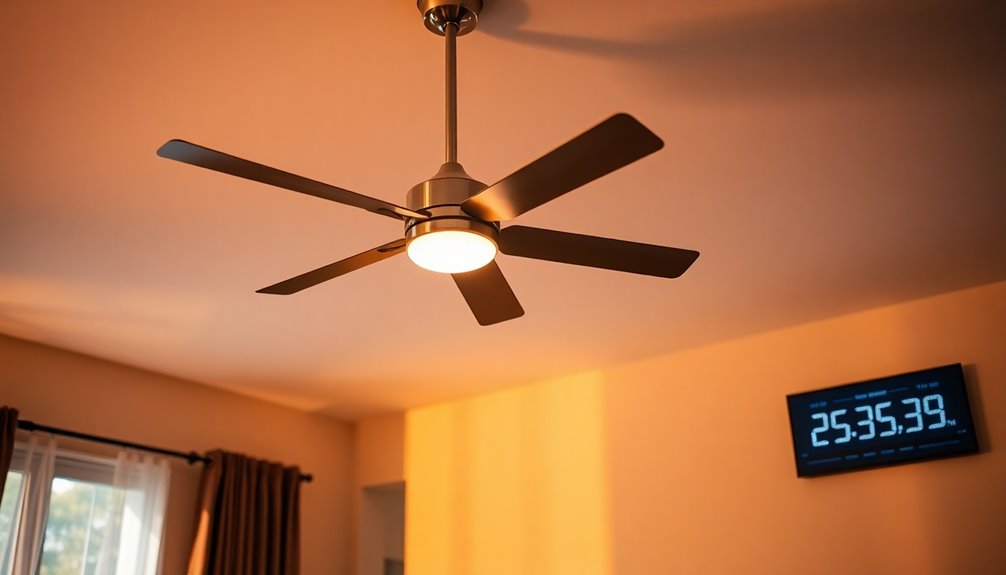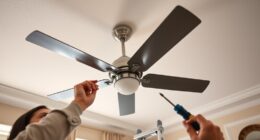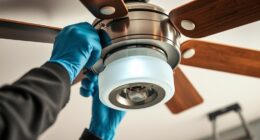The red wire on a ceiling fan acts as a hot conductor, allowing you to control the light fixture separately from the fan. If you want the flexibility of operating the fan and light with different switches, the red wire is crucial. It's often connected to the blue wire, which controls the light kit. If you don't need this feature, you can safely cap the red wire with a wire nut to avoid contact. This guarantees a tidy installation. If you're curious about proper connections or troubleshooting tips, there's more to discover that can enhance your ceiling fan experience.
Key Takeaways
- The red wire in a ceiling fan is used for independent control of the light kit, allowing separate operation from the fan itself.
- It serves as a hot conductor for the light kit, enabling the use of dimmer switches and multiple switch configurations.
- If not needed, the red wire should be capped off securely to prevent accidental contact and ensure safety.
- Proper connection of the red wire enhances convenience, allowing for tailored lighting solutions and operational flexibility.
- Always verify connections when using the red wire to prevent issues like flickering lights or malfunctioning operations.
Ceiling Fan Wiring Basics

When it comes to ceiling fan wiring, what do you need to know to guarantee a safe installation? First, familiarize yourself with the wires you'll encounter. Typically, you'll find a black wire, which is the hot wire controlling the fan's operation. The white wire serves as the neutral, completing the electrical circuit necessary for the fan to function properly.
If your fan includes a light kit, you'll also see a blue wire dedicated to controlling that feature. Don't forget the green wire, which acts as the ground wire for safety. If you come across a red wire in your setup, it may allow for separate control of the light kit, but we'll cover that later.
Properly identifying and connecting these wires is essential. Connect the black wire to the hot wire from your ceiling, and link the white wire to the neutral. The green wire should connect to your ground. This setup guarantees your ceiling fan operates safely and effectively.
Always double-check your connections and adhere to local electrical codes for the best results.
Function of the Red Wire

Understanding the role of the red wire in ceiling fan wiring can really enhance how you control your fan and light setup. The red wire primarily provides independent power to the light kit, allowing you to operate the light separately from the ceiling fan. This means you can turn the light on or off without affecting the fan's functionality, offering you greater flexibility.
When you connect the red wire, it enables you to use different switches for your fan and light. If the wiring doesn't include the red wire, you'll find that both the fan and light will operate together from a single switch, which limits your control. This is particularly important if you want to use dimmer switches for the light, as the red wire is essential for providing that independent power.
Some fan models may label the red wire differently, such as R or L2, but its function remains the same.
When Is a Red Wire Needed?

You'll need a red wire when you want to control your ceiling fan and light independently.
This wiring option gives you the flexibility to upgrade your fan and enhances the overall functionality of your lighting setup.
Without it, you're stuck with a single switch that limits your control over both fixtures.
Independent Light Control
The red wire in a ceiling fan setup plays an essential role in achieving independent light control, enabling you to operate the light fixture separately from the fan motor. When you have a red wire, you can use two separate switches—one for the fan and another for the light—providing greater convenience and flexibility in your home.
This setup is particularly advantageous when you want to turn on the light without activating the fan or vice versa.
If your ceiling fan doesn't have a red wire, both the light and fan will operate together from a single switch, limiting your control options. This is where the red wire shines, especially during the addition of a light kit to a fan, as it allows for independent power without extensive rewiring.
Moreover, utilizing a red wire is vital for installations involving dimmer switches. It lets you dim the light while keeping the fan running at a consistent speed.
Wiring Flexibility Options
When considering wiring flexibility options for your ceiling fan, knowing when a red wire is necessary can greatly enhance your setup. The red wire coming from the ceiling is essential for achieving independent control of your fan and light fixture.
Here are three key scenarios where you'll need it:
- Adding a Light Kit Later: If you plan to install a light kit later, the red wire simplifies your setup, allowing you to connect the white wire easily without extensive rewiring.
- Multiple Switches: In homes with multiple switches, the red wire allows you to turn the fan and light on and off from different locations, enhancing convenience.
- Ceiling Fan Remote: If you want to use a ceiling fan remote, the red wire is often used to control the light separately, providing flexibility in operation.
If you skip the red wire, both the fan and light will operate together from a single switch, limiting your control options.
Enhanced Functionality Benefits
While considering how to enhance your ceiling fan's functionality, recognizing the importance of the red wire can greatly improve your experience. The red wire allows for independent control of the light kit, offering greater user convenience. This feature becomes essential when you use multiple switches to operate different aspects of your ceiling fan and light.
Here's a quick comparison of scenarios with and without a red wire:
| Feature | With Red Wire | Without Red Wire |
|---|---|---|
| Independent Control | Yes | No |
| Dimming Capability | Yes (with dimmer switches) | No |
| Adding Light Kits Easily | Yes | Requires re-wiring |
In installations featuring dimmer switches, the red wire enables you to dim the lights without affecting fan speed. If your lighting needs change, it allows for easy additions of light kits. However, if you have modern ceiling fans with remote controls, the red wire may not be necessary, as those designs often simplify wiring by integrating control functions. So, understanding the red wire's role can profoundly enhance your ceiling fan experience.
Connecting the Red Wire

Connecting the red wire in your ceiling fan setup lets you control the light independently from the fan motor. This is especially useful if you want separate switch controls for your fan and light kit, providing you with maximum convenience.
Here are three key steps to connect the red wire:
- Turn Off the Power: Before you start, make sure the power is turned off at the circuit breaker to avoid any electrical hazards.
- Identify the Wires: Locate the red wire from the ceiling fan and the blue wire, which usually provides power to the light kit.
- Connect the Wires: Twist the red wire together with the blue wire securely. This connection allows the light to operate independently of the fan motor.
If you don't need the red wire for your setup, cap it off with a wire nut to prevent accidental contact.
Tips for Wiring Safely

After confirming the red wire is properly connected, it's essential to prioritize safety during the wiring process. First, always turn off power at the circuit breaker and verify it's off with a voltage tester. This prevents electrical shock and keeps you safe while you wire a ceiling fan.
Next, use insulated tools and wear safety goggles and gloves to protect yourself from potential hazards. When connecting wires, double-check that you've identified them correctly—black for hot, white for neutral, and green for ground. This guarantees you connect wire properly and avoid installation errors.
As you work, make certain all wire connections are tight and secure. Use wire nuts to cap any unused wires, preventing short circuits that could cause issues later.
Remember to follow local electrical codes and manufacturer instructions to guarantee your work is compliant and safe.
Finally, take your time during the installation process. Rushing can lead to mistakes that may compromise safety. By adhering to these tips, you'll create a safe environment while installing your ceiling fan.
Ceiling Fan Wiring Methods

When installing a ceiling fan, understanding the wiring methods is vital for guaranteeing proper functionality and safety. Here are three key components to take into account:
- Red Wire: This wire is essential for providing independent power to the light kit, allowing you to control the light separately from the fan.
- Black Wire: This wire typically connects to the fan motor and directly controls the fan's operation.
- White Wire: The white wire is neutral and connects to the electrical box, completing the circuit for both the fan and the light.
When you wire from the fan, connect the red wire to the blue wire of the fan if you want the light to be controlled separately.
If you don't need independent light control, cap off the red wire with a wire nut for safety.
In some models, the red wire may be labeled as R or L2, but its function remains the same.
Troubleshooting Wiring Issues

Troubleshooting wiring issues with your ceiling fan can be straightforward if you know what to look for. The red wire is essential as it serves as a hot conductor, allowing for independent control of the light kit with a separate switch. If your fan and light operate together from a single switch, check if the red wire is properly connected. For separate control flexibility, connect the red wire to the black wire of the light kit. If you don't need the red wire, cap it with a wire nut for safety.
Flickering lights often signal a loose connection. If the light isn't working as expected, tighten the red wire connection. Additionally, if your fan operates while the light doesn't, or vice versa, it's time to verify connections. Confirm the red wire is correctly wired to its corresponding switch and that all connections are secure.
Taking these steps not only improves functionality but also enhances the security of your ceiling fan setup. By addressing these wiring issues, you can enjoy a fully operational ceiling fan and light fixture that meet your home's lighting needs.
Maintenance and Safety Tips

Maintaining your ceiling fan is vital for guaranteeing its longevity and safe operation. Regular checks can prevent hazards like electrical shock or fire caused by loose or frayed wires. Here are some key maintenance and safety tips:
- Turn off the power: Always switch off the power at the circuit breaker before you start any maintenance. This step is significant to avoid accidents.
- Use a voltage tester: After turning off the power, use a voltage tester to confirm that the power is off at the ceiling box. This verifies you're safely working on the fan.
- Inspect wiring connections: Regularly check the wiring connections, including the red wire, to verify they're secure and free from wear. If you find any loose or frayed wires, it's best to address this immediately.
Additionally, keep the fan clean by dusting the blades and housing to prevent buildup.
If you're unsure about any wiring connections or encounter issues, don't hesitate to consult a licensed electrician. They can help you safely install a ceiling fan and verify everything meets safety standards.
Your safety and the fan's efficiency depend on proper maintenance!
Frequently Asked Questions
What Do I Connect the Red Wire to in a Ceiling Fan?
To connect the red wire in a ceiling fan, you'll typically link it to the light kit's black wire.
If you want separate control for the fan and light, attach the red wire to the corresponding red wire from the ceiling.
Make certain to cap off the red wire with a wire nut if you're not using it.
Always double-check that the circuit is off before you start wiring to guarantee safety.
What Do I Connect the Red Wire To?
Did you know that nearly 80% of households use ceiling fans for energy efficiency?
When connecting the red wire, you typically attach it to the blue wire, which controls the light kit. This setup allows you to operate the fan and light independently.
If your fan doesn't have a light, cap the red wire with a wire nut.
Always double-check connections to guarantee everything's secure for safe operation.
Can I Connect Red and Black Wires Together?
You can connect the red and black wires together, but it isn't recommended.
This connection will cause both the light and fan to operate from one switch, limiting your control. If they draw too much power simultaneously, you risk tripping breakers or even starting an electrical fire.
Always follow the manufacturer's instructions and consult a qualified electrician before making any connections to guarantee safety and prevent potential damage.
Is Red the Same as White Wire?
No, red isn't the same as white wire.
The red wire typically carries power, often for a light fixture, while the white wire serves as the neutral, completing the circuit.
If you mix them up, you could create safety hazards or malfunctioning devices.
Always double-check your wiring before making connections, and guarantee you're using the correct wires for their intended purposes to maintain functionality and safety in your electrical projects.
Conclusion
In summary, understanding the red wire in your ceiling fan setup can make all the difference. Whether it's for a light kit or controlling fan speed, knowing its purpose guarantees a smooth installation. Remember, safety first—wiring can be intimidating, but with care and attention, you'll have your fan spinning and shining in no time. So, why not jump in, embrace the challenge, and let your ceiling fan dance to your tune?









